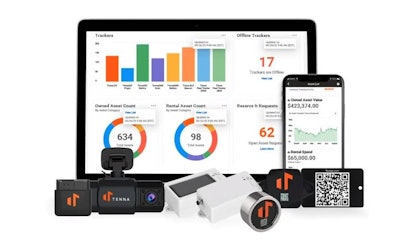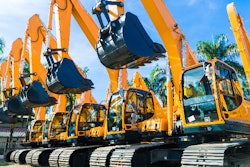
Thanks for joining us on another Product Snapshot edition of Construction tech talk. This is Technology Editor Charles Rathmann.
For many contractors, equipment is a central driver of both value and cost. There are literally hundreds of fleet management solutions in the IronPros product database, but are they all equal in their ability to handle the unique needs of construction? We’ll find out as we talk about … Tenna.
So why do we see so many location-based fleet management systems? Well, according to VC venture fund Space Capital, the space-based GPS signal was the driving technology behind 764 different companies that raised 77 billion dollars in equity financing. It seems like everyone and their dog wanted to get on the bandwagon and cash in.
What’s interesting about Edison New Jersey-based Tenna is that the founders Austin Conti and Jose Cueva weren’t chasing VC cash—they came from the construction industry and when they hung a shingle in 2015 they were chasing a better way to manage equipment assets used on projects. And they must have been onto something.
Tenna’s revenue from hardware and software grew four hundred percent between 2020 to 2021. When I spoke to Tenna in February of this year, they employed 90, with a high percentage of those folks focused on delivering the solution to customers.
Tenna is both a hardware and a software company, and when you research them online you see a lot of their video content is about the hardware, installing it, and how rugged it is.
Man, every time I watch this guy wail on the Tenna Cage, which makes their already robust Tenna Mini more durable … I feel it all the way to my spine.
Now I need some Naproxen.
Tenna offers powered telematics sensors that capture not just equipment location but operating data from heavy equipment. They also offer Bluetooth Low Energy Beacon Trackers that rely on Bluetooth—an app picks up the equipment data when a mobile device comes within range. Now unlike competitors less focused on construction, Tenna handles installs and go-lives with their own veteran staff who know equipment, how it is used and the importance of automated data capture not just on location, but utilization and condition.
Tenna just doesn’t let you manage equipment location—but what it is costing, whether preventive maintenance is being performed, and whether you are about to rent a piece of equipment that duplicates one sitting idle on a construction site.
The hardware offering is comprehensive … safety cameras, QR code tags, trackers for on the road trucks and units designed for heavy equipment—dozers, excavators, cranes, pavers … engine powered generators … and more. But don’t let this hardhat and rugged image fool you—Tenna is also a technology-forward software company that takes data collected from its telematics units and turns it into actionable business insight.
Tenna can give customers visibility of their entire estate—dozers, concrete trucks, F150s, cranes, trench boxes, attachments … all of it—on a single pane of glass.
So let’s look at the software … now keep in mind Tenna is a robust and modular solution, and depending on a customer’s immediate needs and pain points, the equipment they want to track and what software they already have, they may opt for different parts of the asset management, maintenance, safety and hardware offering.
But from a high level, the software gives senior management the ability to track total asset value and break it down by asset category. It also offers visibility into utilization to support buy, sell or rent decisions.
But where Tenna really shines is the ability to tie equipment utilization to projects through integrations with ERP and project management software, and ticket pieces of equipment to specific projects for billing and scheduling purposes. Location, utilization, who is responsible for it … all centralized into one tool.
Opening a new project in Tenna will create a geozone and deliver a real-time view of all the equipment on that job.
Equipment utilization data from Tenna is shared through integrations with project management software like Procore and construction ERP software from Vista, Sage and others. It is also retained within Tenna to support that function that protects and ensures capacity of that equipment … maintenance.
Based on configurable criteria, Tenna can use utilization data to automatically trigger preventive maintenance based on hours of use, so when that equipment is deployed on its next job it will run reliably and properly—and this saves between three to five times the cost of maintenance versus a reactive maintenance approach.
So what’s this stuff made out of? Because this is multi-tenant software as a service, end users don’t have to touch this technology. But it’s still important because it gives you an idea of how it will perform. And what we see here is a thoroughly modern, robust tech stack.
Tenna software resides on Amazon Web Services, on 14 nodes and five availability zones—so failover from one node to another if there is a problem on AWS should be reliable. Under the hood we see the object-oriented PostgreSQL and DynamoDB databases, and heavy usage of the React opensource Javascript library for the front end. Tenna drives functionality to native applications for both Android and Eye Ohs devices.
One cool thing about multi-tenant sass is that it can be updated frequently for bug fixes, security patches and new functionality. Tenna’s updated typically at least twice a month -- with major updates rolling out four times a year. In March of this year for instance, Tenna rolled out a new resource management tool to enable contractor to manage the sharing of equipment and labor resources across sites—pretty cool stuff.
But construction software needs to connect to other software, and Tenna is designed for this from the ground up with its microservices or service-oriented architecture that can easily expose parts of the software as web services for other technologies to consume. Out of the box, Tenna exposes six RESTful application programming interfaces or APIs. A lot of Tenna’s development resources will likely be focused on new no-code interfaces to OEM telematics solutions, enterprise resource planning software and project management applications. The software can even talk to older on-premise software, either through third party connections or in a pinch with an open database connectivity interface.
Now—let’s talk about price. Since the product has multiple capabilities, pricing is determined not just by users, but also the number of assets, the hardware profile and which parts of the software are leveraged.
In some cases there can also be monthly data charges based on the use case. Tenna does on-site training and installation of the hardware, which is part of an up-front cost that Tenna will finance if the customer wants that.
Cost isn’t just money though—it’s time. Time and dollars involved in standing up the solution will depend on scope, the number of assets to be uploaded, the number of locations and travel days between sites. With fewer assets all in one state, Tenna may be live in a couple days.
It can go into weeks if asset lists aren’t ready or because of change orders and addendums. It also helps if the user base technologically astute and engaged.
So who is Tenna for?
Tenna’s meat and potatoes customers have been heavy and highway contractors with between $50 million and $500 million in revenue. The entry level for contractors where Tenna may be a fit, according to company sources, is about $10 million in revenue, at least if that company is targeting substantial growth. But Tenna’s technology and ability to deliver can scale all the way up … the company recently secured Indianapolis-based Infrastructure and Energy Alternatives as a new customer, a publicly traded contractor with more than two billion in revenue.
So what’s the bottom line on Tenna? Well, they’re a very different animal from horizontal players like Verizon. And while they bump heads with HCSS which after all stands for Heavy Construction Software Solution, Tenna is more exclusively focused on assets, telemetry and maintenance. Fleetio may be about as technologically advanced, but not as dedicated to construction as Tenna in either hardware or software. My guess is Tenna will continue its explosive growth and should be near the top of the list of equipment fleet operations packages for mid-sized to large contractors.















